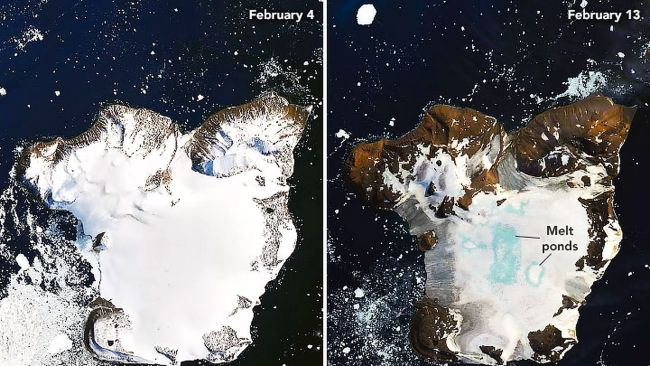 Antarctica's Eagle Island on Feb 4th and Feb 13th 2020. Image Credit: © NASA Earth Observatory
Antarctica's Eagle Island on Feb 4th and Feb 13th 2020. Image Credit: © NASA Earth Observatory
After Antarctic temperatures recently hit record highs twice in the space of one week, it has been revealed this heat wave melted around 20% of the snow of one of its islands, as illustrated by new NASA Earth Observatory images.
During the heat wave, around 4 inches of snow covering Eagle Island melted as well as the highest ever temperature recorded on the continent reaching 64.9 degrees Fahrenheit (18.3 degrees Celsius), the same as temperatures in Los Angeles on the same day.
The images of Eagle Island, captured by NASA’s Landsat-8 satellite on February 4th and February 13th, reveal the startling difference nine days of record-breaking temperatures can make on the planet’s coldest continent. While the usually anomalous high temperatures are a cause for alarm, the picture of a snow-covered island transformed into one with melt-pools and exposed rocky terrain has researchers concerned about the effects climate change is having on the region.
You see these kinds of melt events in Alaska and Greenland, but not usually in Antarctica.
Mauri Pelto, Professor of Environmental Science, Nichols College, Massachusetts
Antarctica’s Record-Breaking Summer
Such dramatic snowmelt is the result of increased temperatures over a sustained period of time which is thought to be the result of overall global temperatures rising. However, other conditions also influenced the sudden heat wave in the Antarctic climate including unusually weak winds which prevented a warm surge moving southwards from Chile and penetrating the continent.
The accelerated melting of snow and glacial ice has caused an increase in the amount of meltwater pouring into the oceans from the Antarctic peninsula. Climate scientist Xavier Fettweis made calculations that could signify that the recent heatwave is the largest contributor to rising sea levels since November 2019. While Fettweis’s calculations would need to be confirmed, the figures show the impact the current climate crisis is having on the planet.
The most recent heatwave in Antarctica comes on the back of an extraordinarily warm summer for the continent as January 2020 was declared the Earth’s hottest January on record as well as November 2019 being confirmed as the second hottest November on record. Furthermore, each of these events is peculiar as there was a distinct lack of an El Niño presence during this period. This has led to NOAA announcing in its climate report that polar sea ice coverage was less than usual with the Antarctic sea ice 9.8 percent below the average.
Ramifications of Increased Temperatures
The continuation of temperatures significantly above zero in the Antarctic region was not common until the turn of the 21st century. Moreover, the occurrence of relatively high temperature spikes on the continent is becoming more frequent with each passing year. And while a combination of meteorological conditions contributed to the recent melt, this was the third major snow and ice melt on the continent over the 2019-2020 summer period. “If you think about this one event in February, it isn’t that significant,” said Pelto. “It’s more significant that these events are coming more frequently.”
Consequently, the curious climate conditions in the Antarctic region also correlate with alarming long-term trends such as increased CO2 emissions which could lead to scientists classifying this as a climate event. Experts also expect to see more extreme warm weather events in the region as well as more impactful ice melts. One of the major concerns is that continued ice loss in the polar regions could lead to severe rises in sea levels, which would put much of the world’s coastal populations at risk.
Other significant ramifications of snow and ice melts on the continent include the ice calving event off the continent’s Pine Island Glacier, coinciding with rises in greenhouse gases which also trap heat in the region. ESA researchers believe that events such as the Pine Island Glacier break-off is also likely due to anthropogenic climate change. Thus, we could see much more than 20% of the barren, rocky Eagle Island landscape exposed if warm weather events and record breaking summers persist in the Antarctic region.
Disclaimer: The views expressed here are those of the author expressed in their private capacity and do not necessarily represent the views of AZoM.com Limited T/A AZoNetwork the owner and operator of this website. This disclaimer forms part of the Terms and conditions of use of this website.